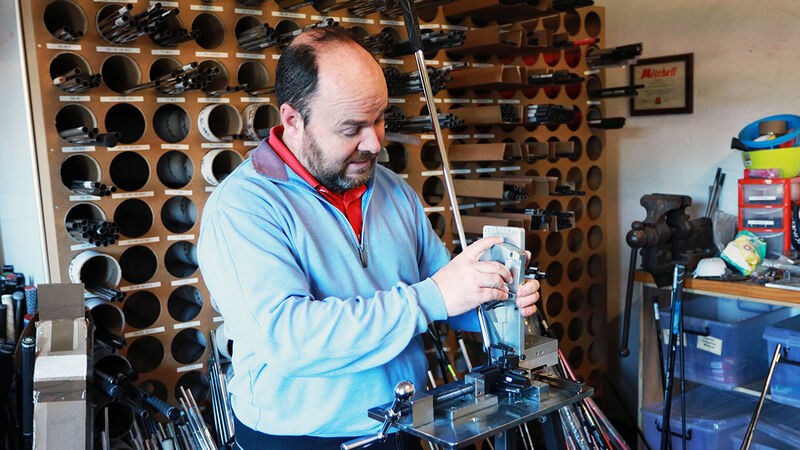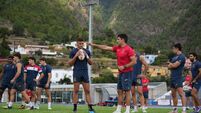Cork Golf: Your guide to picking the right set of clubs

Padraig Dooley building a club in his Glanmire workshop. Picture: Niall O'Shea
IT'S that time of year, the manufacturers have released their new golf clubs and the dazzling marketing claims and new terminology are tempting golfers to change.
Speed optimised, jailbreak speed frame, carbonwood, rebound frame and zero CG are some of the buzzwords doing the rounds this year as the manufacturers do their best to convince golfers to upgrade.
While the technology continues to improve, the price also increases with new drivers now averaging over €500 in the premium space and iron sets even more expensive.
For many club golfers a new set of clubs might cost more than their annual subscription.
While many golfers will buy off the shelf, an increasing number are choosing custom fitting.
Padraig Dooley is a PGA professional and for well over a decade he has been building up a large base of customers who visit for custom fitting as well as lessons.
Most golfers will have heard of custom fitting and Padraig has a very clear way of describing it.
“Custom fitting is simply the process to decide on the golf equipment that suits you best," Dooley said.
"The goal of custom fitting is to get the golfer hit longer and straighter shots and ultimately lower scores.
"The clubs are built for you from the specifications identified from the custom fit.”
Like other golf retailers Padraig sells the full range of clubs from all manufacturers, but he rarely sells clubs without some element of fitting or analysis.
“The easiest way for a golfer to improve is to start using clubs that suit them better,” explains Padraig.
“There is no practice involved, the golfer just goes out and plays. It wouldn’t be unusual to see 10-15 yards extra with a driver and more accurate irons that would lead to a 2-3 shot drop in handicap.”
And fitting is not just relevant for better golfers with everyone benefitting from the process.
“Generally, it’s the medium to high handicap golfer that sees the most improvement. It’s much easier for an 18 handicap to drop 3 shots then a 2 handicap,” says Dooley, and it’s certainly not the case that high handicappers aren’t consistent enough to benefit from the custom fitting process.

“This might be the biggest fallacy in the thinking of some golfers. They think that if they make five swings the five swings will all be different and that they look like Ernie Els on good swings and Jim Furyk on bad swings.
"This isn’t true, for all golfers most swings don’t change much, the swing speed stays the same, the club path stays the same, the club release stays the same, the swing transition stays the same.”
Padraig and his brother John, also a PGA Professional, started Drive Golf Performance in 2012, and the pair have built an impressive business from their base in Riverstown.
The workshop is an Aladdin’s cave for golfers with thousands of pieces of equipment.
From junior clubs to a huge range of putters and wedges, to the latest driver and iron heads, there’s equipment from wall to wall.
The custom fitting process can be a simple discussion but Padraig explains what the more detailed fittings can include.
“It can be an in-depth session where an experienced fitter takes you through hitting different club specifications such as length, lie angle, shaft, shaft flex, head design and grip size, record the results on a launch monitor such as Trackman and compare the results to your own set to see the difference between them.”
As Padraig charges a fee for fittings, there isn’t a requirement to buy or upgrade clubs.
“The fitting session is only an information-gathering exercise. After the session, the golfer can decide to buy a new set, stick with their own set, retrofit their own set, which would be changing specifications such as shaft, length, lie angle, grip size or buy a pre-owned set with specifications that suit them better.
"Most manufacturers will have a lot of options that require no upcharge on a standard priced set, but there are plenty of exotic shafts and heads that will cost more too.”
Many golfers' experience of fitting would have involved a decision between steel or graphite shafts, the two main technologies in place for the past twenty years, and Padraig Explained the main differences between the two materials.
“Graphite shafts are great for absorbing shock when hitting a ball, so if the golfer has hand, wrist and arm trouble, graphite will be very helpful. Graphite is also more adaptable than steel and can be designed to give a lot more shot trajectories than steel.
"Generally, if a shaft is too flexible for a golfer, shots will go higher and curve more to the left, if they are too stiff, shots will go lower and to the right.
"If the ball flight is too low with the driver a more flexible shaft might give a higher flight and longer distance.”
One of the most impressive places in the Riverstown workshop, where close to a thousand shafts are stored.
Hundreds of different shafts are in stock with Padraig knowing the technical specification of each shaft, in addition to how the specific role it will play for each golfer.
Not only do the new generation of shafts have incredible artwork, they also have the latest technology in terms of materials providing numerous options in terms of tempo, trajectory and spin.
Like the club, the new shafts generally mean higher prices due to the better materials and the quality control process.
Dooley says the increased cost can be justified with a 22% increase in accuracy over standard shafts.
Whatever the final decision, golfers will have plenty of options when it comes to deciding on a final combination of head, shaft and grip.







 App?
App?










